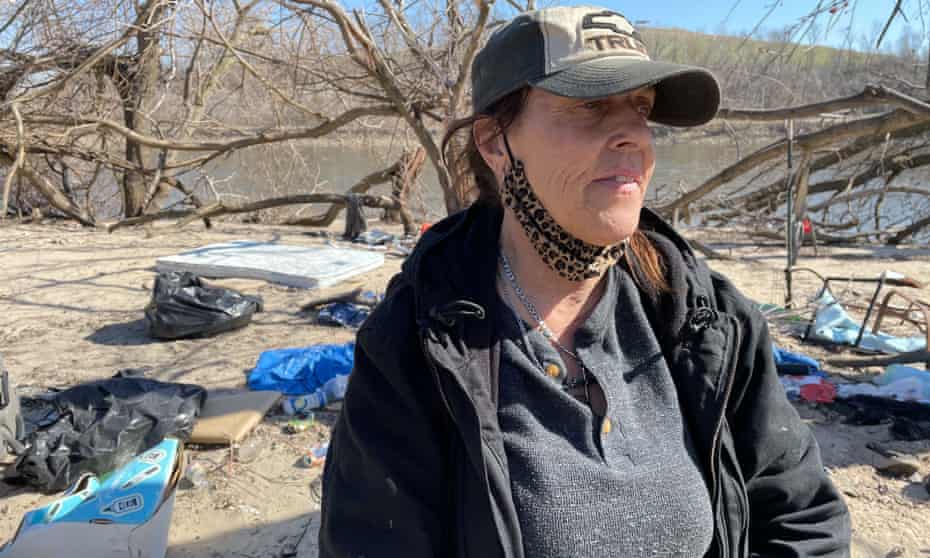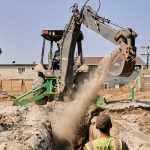Terri Domer knows well what a brewing storm looks like.
Domer, 62, an Iowa native, has spent her life watching thunderstorms gather and tornadoes dash across rolling hills. Last August, when the midday sky darkened over the riverside homeless encampment where Domer and four other people spent most nights – built on a sandy bank near downtown, under tall trees – she quickly set about covering up their supplies.
As if in an instant, the sky grew “black,” Domer said – darker than she’d ever seen it.
The derecho hit with a fury, winds whipping up sand and snapping limbs overhead. Domer rushed for cover, pulling a tent canopy over her head. All around her, branches and whole trees crashed to the ground.
“I kept thinking, ‘When is it going to stop?’” Domer said. She said a prayer that she would live.
It’s an immutable truth of the climate crisis that the most vulnerable are hit first and hardest. At a time of rising homelessness in the US and as climate-related disasters become common – wildfires in California, monster hurricanes that thrash the east coast and the Gulf of Mexico, an arctic blast in Texas – the rule holds.
“We’re definitely seeing more homelessness, more housing disruption, as a result of these disasters,” said Steve Berg, programs and policy director at the Washington-based National Alliance to End Homelessness.
Climate change didn’t directly cause the midwest derecho last year or any of those other disasters. Scientists are clear, however, that a warmer planet makes extreme weather more likely and more ferocious. For people experiencing homelessness, like Domer, the storms make matters only more difficult. Others are made homeless. In both cases, government agencies and nonprofits provide support, but increasingly the needs exceed their capacity.
There are an estimated 580,000 people experiencing homelessness in America, based on a single-night count in January 2020 — the fourth straight year homelessness had increased, according to a study released last month by the Department of Housing and Urban Development (Hud). It was the first year since Hud began collecting data that the number of homeless people with children had gone up. People of color remained starkly overrepresented compared with the US population overall.
Crucially, that’s all pre-pandemic data, and the reality is likely to be worse than we know. Millions lost work because of Covid-19, and even as the economy recovers, there remain 8.4m fewer jobs than before the pandemic hit. Eviction moratoriums have helped, advocates say, but as some of those expire soon, the situation could grow more dire still.

When the windstorm finally did let up, about 45 minutes after it had begun, Domer’s campsite was in tatters. What struck her the most, however, was the quiet. Gone were the normal afternoon sounds of the city. Even the nearby corn processing plant, a reliable source of ambient churning, was silent.
“I realized the whole town had been hit, and I thought, ‘Oh, my God,’” Domer said.
For the homeless, natural disasters prove torturous for more than the obvious fact that it’s worse to be outside than inside during a storm.
Only one-quarter of the homeless population is considered “chronically homeless,” meaning homeless for more than a year or experiencing repeat bouts of homelessness. At any given time, then, the vast majority of homeless people, including some who are chronically homeless, are scraping their way back toward stability. After disasters, backslide is all but inevitable.
Encampments are destroyed. Resources, often hard-won, are lost. If infrastructure is damaged, a job might become more difficult or impossible to get to.
Furthermore, many people who are homeless wrestle with untreated medical or mental health conditions that disasters might worsen. Domer, who suffers from post-traumatic stress disorder, said the derecho triggered substantial anxiety and depression, which she’s still coping with.
After the derecho, a short distance from Domer’s and Murphy’s encampment, Kari Fisher surveyed the damage to the duplex where she lived with her husband and six children, ages 1 to 10.
When the storm hit, Fisher had been home-schooling, a new responsibility due to the pandemic but one she enjoyed. Structural damage to the home was clear; in the unit opposite Fisher’s, a tree had smashed into the kitchen. City officials declared the home unfit for habitation, but with nowhere else to go, Fisher’s family stayed. Power was shot for good, so for months they got by using plastic coolers and a propane camping stove. (Thanks to the downed trees, Fisher jokes, they also had plenty of wood.)
In November, police cited the family for unlawful habitation. They were directed to Willis Dady, a homeless services nonprofit, which moved the family into a Hampton Inn & Suites north of town, using federal emergency funds made available to the city.
Fisher expected they’d be there for a couple weeks. Six months later, fully eight months on from the derecho, they’re stuck. In two hotel rooms, it’s Fisher, her husband, an ex-husband who has a disability, seven children – Fisher gave birth to a boy in February – and two dogs. In the same Hampton Inn & Suites, there are dozens more like Fisher, and it’s not the only hotel in town still housing people made homeless by the storm.
“It feels like sardines,” Fisher said. “It’s not sustainable.”
While her husband works, Fisher spends days searching Zillow, Zumper, Craigslist and Facebook Marketplace for available homes. On rental application fees alone, the family has spent more than $4,500 – dipping ever further into diminished savings – but nothing comes through. With so many people looking, by the time most units are listed, they’re already gone.
“We’re in a hole,” Fisher said. “No matter how much I do, no matter how many phone calls I make, we’re still here.” As of mid-April, the family hoped to move into a trailer.
Fisher’s situation, advocates said, is characteristic. Since Hurricane Katrina in 2005 – the first major storm in the US that scientists linked to climate change – disasters have been routine drivers of new homelessness.
In Houston, for example, homeless rates fell year over year starting in 2012. In 2018, the year after Hurricane Harvey, they ticked back up. Last year, 11% of the city’s unsheltered homeless population said they had become homeless because of the hurricane or another natural disaster, according to a survey by Houston’s Coalition for the Homeless.
According to the National Low Income Housing Coalition, America is short nearly 7 million affordable housing units. During an extreme weather event, affordable housing – more likely to have been built in disaster-prone areas in the first place – is especially vulnerable and often hit the hardest, shrinking the already limited inventory.

The pattern goes like this: Disasters push people who had been housing secure toward insecurity. People who were already insecure or severely burdened by housing costs are pushed to the edge of homelessness. And, finally, people who were already homeless are pushed further back in the long wait for limited resources.
The web of government agencies and nonprofits designed to help, meanwhile, is stretched to the max.
In Cedar Rapids, Willis Dady typically serves 500 people in a year, including those who are actively homeless and those who are at risk of becoming homeless. Now, given the combined effects of Covid-19 and the derecho, 500 people need assistance every day, said Alicia Faust, the organization’s executive director.
To fully meet the demand, Faust said, she would need 16 full-time homelessness prevention case managers, working 30 to 35 cases apiece. Willis Dady has three.
In some cases, solutions to homelessness and the climate crisis might be one and the same.
Between coronavirus relief measures passed during the Trump administration and the $1.9tn American Rescue Plan that Joe Biden signed last month, nearly $80bn was allocated to Hud, the treasury department and various federal grant recipients to fight homelessness and housing instability, a Hud spokesperson said in an email. Moreover, the White House’s newly announced $3tn-plus infrastructure plan includes funding to build and retrofit 1m affordable and energy-efficient housing units.
Another promise of Biden’s infrastructure proposal and Climate Action Plan: millions of jobs, as the administration seeks to build out America’s clean energy infrastructure.
Advocates for the homeless expressed cautious optimism. New affordable housing is a clear win, while the benefits of upgrading and retrofitting existing units are twofold: Just as energy efficiency is good for the planet, it lowers utility costs for renters. As for jobs, many people who experience homelessness find work in construction already. If enough training is packaged with the green jobs in Biden’s plan, as the administration says it will be, those jobs could be an apt fit and a much-needed path to stability.
“Anything would help,” Domer, who herself has a background in construction, said. “The pandemic was already tough, and then a derecho. We’re still trying to figure out what normal looks like.”
This story originally appeared in NBC News and is republished here as part of Covering Climate Now, a global journalism collaboration strengthening coverage of the climate story

Average Rating